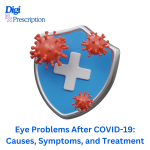
COVID-19 has affected millions worldwide, leading to respiratory complications and long-term health issues. However, one lesser-known consequence is its impact on eye health. Many individuals recovering from COVID-19 have reported vision-related problems, ranging from mild irritation to severe complications.
In this blog post, we will explore common eye problems after COVID-19, their possible causes, and how to manage them.
1. Dry Eyes and Eye Irritation
Why Does It Happen?
-
COVID-19 can cause inflammation in various body parts, including the eyes.
-
Prolonged screen time during isolation worsens digital eye strain.
-
Wearing masks frequently leads to Mask-Associated Dry Eye (MADE) due to redirected airflow.
Symptoms:
✔ Grittiness or burning sensation
✔ Redness and itching
✔ Blurred vision and light sensitivity
Treatment:
✔ Use Artificial Tears: Lubricating eye drops help relieve dryness.
✔ Take Screen Breaks: Follow the 20-20-20 rule (every 20 minutes, look 20 feet away for 20 seconds).
✔ Adjust Mask Fit: Ensure your mask sits tightly around the nose to prevent airflow into the eyes.
2. Conjunctivitis (Pink Eye) Post-COVID
Why Does It Happen?
-
The coronavirus can directly infect the conjunctiva (eye membrane), causing viral conjunctivitis.
-
Inflammatory reactions after COVID-19 may trigger eye redness and discomfort.
Symptoms:
✔ Red, swollen eyes
✔ Watery discharge
✔ Itchy or burning sensation
Treatment:
✔ Use Cold Compresses: Helps reduce swelling and discomfort.
✔ Prescribed Eye Drops: Anti-inflammatory or lubricating drops may be recommended.
✔ Avoid Rubbing Eyes: Prevents further irritation and infection spread.
3. Blurry Vision and Light Sensitivity
Why Does It Happen?
-
COVID-19 may cause inflammation in the optic nerve (optic neuritis), leading to visual disturbances.
-
Post-viral fatigue and brain fog can also contribute to focus-related issues.
-
Medications used to treat COVID-19, like steroids, might temporarily affect vision.
Symptoms:
✔ Difficulty focusing on objects
✔ Increased sensitivity to bright lights
✔ Headaches and dizziness when reading or using screens
Treatment:
✔ Wear Sunglasses: Helps reduce light sensitivity outdoors.
✔ Stay Hydrated & Rest: Fatigue-related vision issues improve with proper hydration and rest.
✔ Consult an Eye Doctor: If blurry vision persists, a retinal exam may be necessary.
4. Eye Floaters and Retinal Problems
Why Does It Happen?
-
COVID-19 increases the risk of blood clot formation, which can affect the tiny blood vessels in the retina.
-
Retinal vein occlusion (RVO) or retinal inflammation may occur in severe cases.
Symptoms:
✔ Sudden appearance of floaters (small black spots or strings in vision)
✔ Flashing lights in the peripheral vision
✔ Dark or blurry spots in vision
Treatment:
✔ Seek Immediate Medical Attention: Sudden floaters or flashes could indicate retinal detachment.
✔ Retinal Scans: Eye specialists may perform an OCT (Optical Coherence Tomography) scan.
✔ Manage Blood Sugar & Blood Pressure: Helps prevent further retinal damage.
5. Post-COVID Headaches and Eye Pain
Why Does It Happen?
-
Long COVID can cause persistent headaches that strain the eyes.
-
Sinus congestion from COVID-19 can increase pressure around the eyes, leading to pain.
-
Neurological effects of COVID-19, such as migraine-like symptoms, might impact vision.
Symptoms:
✔ Sharp or dull pain around the eyes
✔ Pressure in the forehead and temples
✔ Pain that worsens with screen time
Treatment:
✔ Use a Warm Compress: Helps relieve sinus-related eye pain.
✔ Reduce Screen Exposure: Lower brightness levels on digital devices.
✔ Try Over-the-Counter Pain Relievers: Consult a doctor before taking pain medications.
6. COVID-Related Uveitis (Inflammation of the Eye)
Why Does It Happen?
-
COVID-19 can trigger an autoimmune response, leading to inflammation in different body parts, including the uvea (middle layer of the eye).
-
Uveitis can cause long-term vision issues if untreated.
Symptoms:
✔ Severe eye redness
✔ Eye pain and sensitivity to light
✔ Blurred vision
Treatment:
✔ Steroid Eye Drops (Prescribed): Helps reduce inflammation.
✔ Regular Eye Checkups: Monitoring for recurring inflammation is essential.
✔ Manage Underlying Conditions: Address autoimmune triggers that may worsen symptoms.
7. Blood Clots and Eye Stroke (Rare but Serious)
Why Does It Happen?
-
COVID-19 has been linked to blood clotting issues, which can lead to ocular strokes (blockage in eye blood vessels).
Symptoms:
✔ Sudden loss of vision in one eye
✔ Dark spots or shadows in vision
✔ Pain is usually absent
Treatment:
✔ Seek Emergency Medical Help: Immediate intervention can prevent permanent vision loss.
✔ Control Blood Pressure & Cholesterol: Helps reduce stroke risk.
✔ Regular Eye Exams: Essential for individuals with a history of COVID-19 and other risk factors.
How to Protect Your Eyes After COVID-19
✔ Stay Hydrated & Maintain a Healthy Diet: Supports eye and overall health.
✔ Take Breaks from Screens: Reduces digital eye strain and fatigue.
✔ Follow Up with an Eye Doctor: Especially if experiencing persistent vision problems.
✔ Monitor Underlying Health Conditions: Diabetes, high blood pressure, and autoimmune disorders can worsen post-COVID eye complications.
✔ Wear Blue Light Glasses: Helps with screen-related discomfort.
Conclusion
Many individuals recovering from COVID-19 experience eye problems, ranging from dry eyes and blurry vision to serious conditions like retinal issues or eye strokes. While some symptoms are temporary, others may require medical attention. Regular eye checkups, good eye hygiene, and a healthy lifestyle can help prevent long-term vision complications. If you notice sudden vision loss, severe pain, or persistent discomfort, consult an eye specialist immediately.
References:
-
National Eye Institute (NEI) – Vision Problems After COVID-19 – https://www.nei.nih.gov
-
World Health Organization (WHO) – COVID-19 and Long-Term Health Effects – https://www.who.int
-
Mayo Clinic – Post-COVID Syndrome and Vision Issues – https://www.mayoclinic.org
